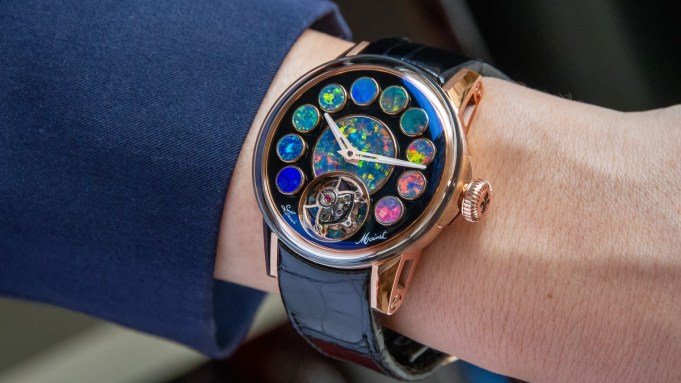Louis Moinet Puts a Twist on Classic Gem Setting in the Geopolis Opal

[ad_1]
As gender lines blur and the watch industry becomes increasingly more playful and colorful with its designs, precious stones have started having a major moment. We’ve seen this trend take shape over the past several years. Collectors began recognizing the value of stone dials, and brands like Piaget and Jaeger-LeCoultre who have consistently done this application well have risen further in prominence. Then came the rainbow craze, which you could say originated all the way back in 2012 with the first Rainbow Daytona but seemed to gain momentum in the past five years, a momentum that hasn’t slowed with nearly every major brand introducing its own take on the color spectrum. Beyond brighter and bolder aesthetics, these two trends share the technical application of integrating precious stones into the art of watchmaking be it on the dial, bezel, case, bracelet, or all of the above.
When it comes to stone dials, the options vary from lapis to malachite, tiger’s eye to onyx, and coral to turquoise. Alternatively, most rainbow watches employ a range of carefully sourced sapphires. Yet, there’s one gemstone that seems widely overlooked: the opal. Now, in part, this oversight may be largely practical. Opals are in fact extremely rare—far rarer than diamonds. However, they achieve a mesmerizing spectrum of colors with just a single stone. Louis Moinet is one watchmaker who has long recognized the allure of the opal. The independent brand has proven to be a master at gemstone, fossil, and meteorite dials, and that lineage continues with its latest release: the Geopolis Opal.

Geopolis Opal
Louis Moinet
With the Geopolis Opal, Louis Moinet uses the application of a stone dial to achieve a rainbow effect—win-win. Here, onyx lays the foundation for ten brilliant opals to shine around the periphery of the dial. A larger opal disc takes center stage, radiating from the hour and minute hands at the dial’s center. Last but not least, a twelfth and final opal is subtly nestled behind the tourbillon at six o’clock. The resulting aesthetic is instantly eye-catching, but this is only half of the puzzle. Behind this gorgeous design is a major technical achievement. Opals are extremely fragile stones, and the cutting process requires extreme patience, precision, and skill. To execute this particular dial layout, each opal had to be carefully cut and polished by hand, then reduced to discs just 0.5mm thick.
The Geopolis Opal is newly available, with the price available upon request by visiting the Louis Moinet website.
[ad_2]
Source link




